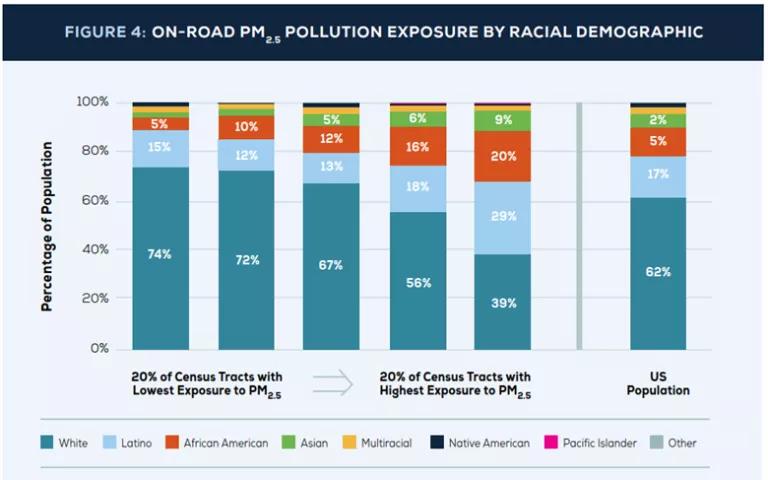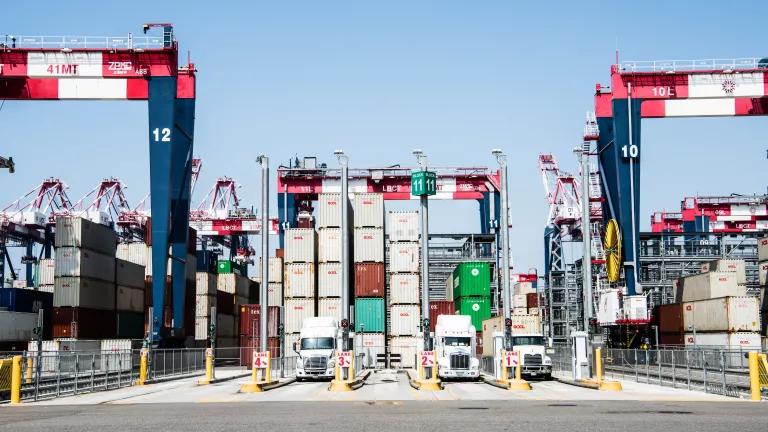State Plan Calls for Bold Leadership on Clean Trucks
A bipartisan group of 17 states released an Action Plan recommending policy options to promote zero-emission medium and heavy-duty vehicles.
Muhammed Patel and Sarah Street are contributing authors to this blog.
The transportation sector is the largest source of greenhouse gas emissions in the United States, and medium- and heavy-duty vehicles are a big chunk of that. These vehicles are also a major source of dangerous air pollution like nitrogen oxides (NOx) and particulate matter (PM) that harm public health, especially in frontline communities located near freight infrastructure, bus depots, trucking corridors, and other emissions sources.
We need to electrify these vehicles to zero out tailpipe pollution and improve local air quality.
States across the country are leading the transition to clean trucks. To foster this transition, a bipartisan group of 17 states is recommending policy options to promote a self-sustaining market for zero-emission medium and heavy-duty vehicles. The Multi-State ZEV Task Force and the Northeast States for Coordinated Air Use Management (NESCAUM) released an Action Plan with a focus on near term strategies. The Plan includes more than 65 recommendations for state policymakers to support the rapid, equitable, and widespread electrification of trucks, vans, and buses. The Plan builds on several years of robust stakeholder engagement and is the next step in a historic multi-state clean transportation memorandum of understanding launched in 2020.
Principles for a just and equitable transition
Truck distribution hubs are often located near low-income communities and communities of color, disproportionately burdening them with hazardous diesel pollution and in turn, the associated health and economic consequences. In the United States, residents of color tend to have significantly higher exposure to PM2.5 concentrations relative to the national average.

Source: Multi-State Medium- and Heavy-Duty Zero-Emission Vehicle Action Plan, Data from UCS
The Plan highlights the importance of an inclusive, accessible, and transparent community engagement process, elevating the voices of overburdened and underserved community members and workers in all aspects of clean transportation planning and decision-making. States should take a “whole-of-government" approach and work directly with community groups to develop robust engagement frameworks that include community input, uplift and elevate community knowledge, identify overburdened communities, and prioritize equity in all aspects of policymaking.
Accelerating the ongoing transition
Today, electric trucks and buses account for just a small fraction of new medium- and heavy-duty vehicle sales. But the number of electric models on the market is increasing and technologies are improving, giving fleet operators a more diverse selection to meet their needs and duty cycles. More than 125 different zero-emission models are currently available across medium- and heavy-duty vehicle types in North America, and this number will likely exceed 240 models by 2023. Supportive government policies and programs are vital to foster market growth and help lower initial entry costs in the coming decade.
States must adopt foundational vehicle sales and purchase requirements
The most effective and immediate ways states can kick off the transition to an electrified future is by adopting clean truck standards. These foundational policies include zero-emission vehicle sales and purchase requirements, such as the Advanced Clean Trucks (ACT) and Advanced Clean Fleets (ACF) rules which require manufacturers increase sale of zero-emission vehicles and set dates by which fleets must fully transition. A handful of states have already moved forward to adopt strong vehicle standards, but all should consider action immediately.
Vehicle and infrastructure incentives are necessary supportive policies
State electrification incentives can help address purchase price differential for the cost of electric trucks and associated charging infrastructure. Smaller fleets, independent owner/operators, and minority-owned fleets in low- and middle-income communities that may not have sufficient funding or access to affordable financing sources to front load the cost would benefit greatly from these incentives. The Plan specifically highlights point-of-sale incentives that provide “cash-on-the-hood," and directs states to cover a portion of the vehicle costs while reserving funding for deployments in the communities most impacted by transportation pollution.
Actions for electric utilities and regulators
Widespread electrification of trucks and buses present grid management challenges and opportunities for utilities. Many fleets will require fast high-powered charging to reduce refueling time, and localized grid upgrades to serve the increased power load. Therefore, utilities and utility regulators play a central role in fleet electrification to ensure a swift transition.
The Action Plan recommends utility regulators and policymakers should eliminate uncertainty and barriers to expansion of electric vehicle charging infrastructure. It highlights the need for advanced planning and preparation for the grid, identifying system capacity needs and adopting “make-ready” infrastructure rules that support development of EV infrastructure. Utilities should modify business structures and provide fleet services programs with a single point of contact to provide comprehensive technical assistance. Regulators should encourage utilities to adopt a range of commercial rate structures and incentive programs tailored to meet charging needs and lower charging costs.
Mobilizing private capital to finance fleet conversions
Government incentives and ratepayer funded programs can offset the higher upfront purchase prices in the near-term, but states also need to drive private sector investment. Currently, many conventional financing options are not available to commercial fleets on favorable terms, especially smaller fleets. The Plan presents several mechanisms to harness ongoing savings by treating electrification costs as more manageable operating expenses.
Outreach and education
Fleets and drivers should know about the hazards of long-term exposure to diesel emissions and the impacts of diesel truck traffic on overburdened communities. The Task Force recommends robust fleet outreach and education initiatives to increase consideration and adoption of zero-emission technology. This should include direct engagement with manufacturers and fleets, or the development of a “one-stop-shop” for information on electrification opportunities.
Economic equity for workers
Workers in the transportation sector and related industries have an important stake in the transition to electric transportation and policymakers must ensure just and equitable outcomes. By helping drive demand for North American manufactured products and supporting the development of its EV industries, states can create jobs here in the US. Equitable access to new jobs requires workforce development programs for workers from overburdened, underserved, and low-income communities. Pre-apprenticeship and apprenticeship programs, wraparound services, and customized training will connect workers to high-quality job opportunities and careers and support life-long employability.
Community air monitoring
The nation’s air monitoring system to measure compliance with federal ambient air quality standards is not designed for monitoring at the community level. Air quality can vary significantly in large study areas. Monitoring at a more granular level can help prioritize electrification in areas disproportionately exposed to transportation pollution. Many government agencies have launched efforts to locate exposure “hot spots” and the characteristics of the communities where they occur to guide decision-making. While that won’t replace regulatory monitoring programs, it can inform future analysis and action, and arm communities with information needed to advocate for improvements in local air quality.
Planning for and deploying public charging infrastructure
As more zero-emission trucks come to market, communities and trucking corridors will need a reliable and accessible network of public charging and fueling infrastructure. States, fleets, utilities, charging and fueling providers, and other key partners must strategically plan in advance. States and municipalities should look for opportunities to dedicate under-utilized parking to cost effectively host charging infrastructure. States should streamline permitting for EV charging depots, and advocate for federal changes to allow user-pay EV charging stations at interstate highway rest areas.
Local and federal government recommendations
Local governments, including municipal and county governments, have an important and unique role to play in facilitating the transition to zero-emission trucks and buses. They exert considerable control over charging infrastructure through zoning ordinances, engineering design requirements, and permitting regulations. They also understand their communities’ needs and opportunities better than their states and federal counterparts.
Local governments should engage in infrastructure planning, pursue non-monetary electrification incentives, leverage property tax credits to encourage charging infrastructure, establish electrification targets, and minimize the administrative burdens on charging infrastructure planning, permitting, and construction.
Federal leadership is also critical to set a national agenda that aligns policy at every level of government, provides critically needed funding, and drives public and private sector action to support electrification of trucks and buses. The Task Force calls for increasingly stringent federal emission standards to protect our most vulnerable populations, streamlined processes around and increased overall ZEV funding. Finally, it recommends a federal leadership role in coordinating and spurring federal, regional, state, and other entities to ensure a seamless network of public charging across the nation.
What comes next for states?
The Action Plan is just the start of the conversation—now comes implementation. With this roadmap in hand, states should create their own customized action plans and prioritize input from the communities most impacted by vehicle pollution. States are in the driver seat, and uniquely positioned to continue pushing the clean transportation transition forward.




